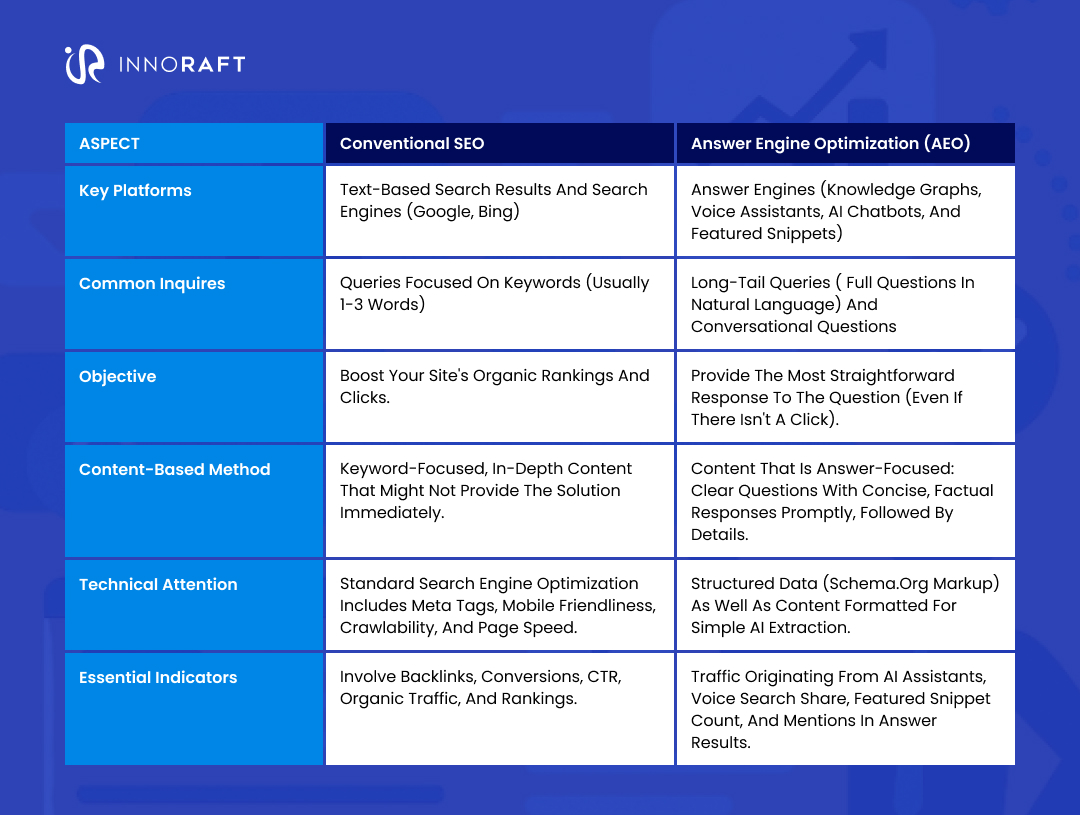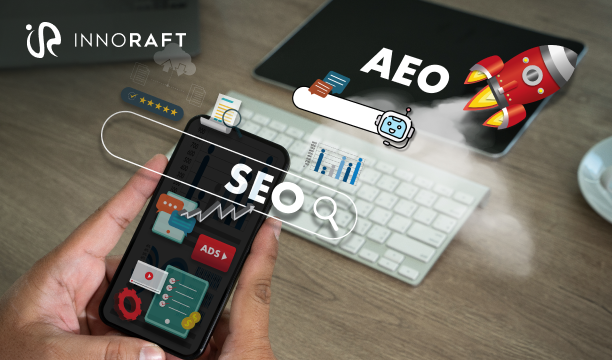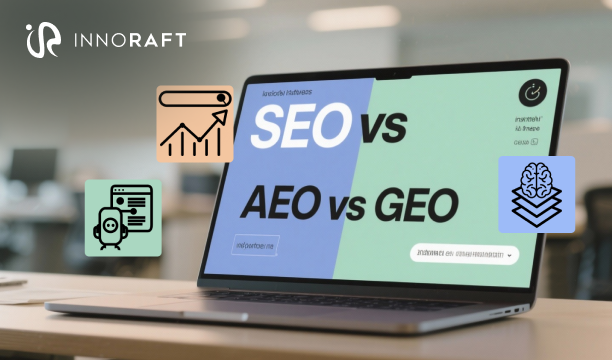Have you ever put a query into ChatGPT and just waited for the answer to appear, without clicking or exploring through websites? You are not alone. More and more individuals are doing the same thing since it's faster, simpler, and feels much more natural than using Google the old way. This shift is fundamentally altering how we look for and utilize information online. This is where Answer Engine Optimization (AEO) arrives. AEO entails curating information to provide brief answers to user questions that can be suggested immediately in AI-generated responses, either through conversational chat, voice search, or an AI-powered search snippet.
As answer engines grow in popularity and AI is more incorporated into search experiences, adopting the AEO strategy has become critical for maintaining digital presence. This comprehensive AEO answer engine optimization guide embraces all you need to know about AEO services and how to use them effectively.
What is Answer Engine Optimization?
Answer engine optimization services ensure that business information appears as direct responses to online queries by aligning modern search behaviors. In order to address the clear goal behind user queries, content must be structured to lead with value and offer answers up front. AEO focuses on making your content easily accessible for AI platforms like Google Search, Google Assistant, Siri, and other AI-powered search tools. In contrast, traditional SEO seeks to rank content higher by optimizing for keywords.
Fundamentally, AEO services use natural language processing and structured data to deliver succinct, pertinent responses that are suited to the user's intent. The emphasis on user queries rather than just keywords is what sets apart answer engine optimization (AEO) strategy. By handling the explicit intent behind queries like "Know" or "Know Simple", AEO ensures that content stays valuable and relevant for users looking for associated details.
What Differentiates AEO from Conventional SEO?
Creating a successful digital strategy requires an understanding of the key differences between traditional search engine optimization and AEO optimization:

Regardless of these differences, SEO and AEO work well together. Both seek to meet user needs and improve online visibility. Effective AEO frequently requires a strong SEO foundation as several fundamental tactics overlap.
Essential Components of a Successful AEO Strategy
Focus on these crucial elements to put into practice a successful aeo answer engine optimisation strategy:
Implementation of Structured Data
Adding structured data helps make your web content easier to understand. Using schema markup lets search engines grab important info from your page. They can then show it off in cool ways, like in rich snippets or answer boxes. This ensures that AI systems can find your content with ease.
For instance, Schema.org, can be used to indicate to search engines the type and intent of your content by labelling items such as product descriptions, FAQs, and recipes.
Important AEO schema types include:
- Structured Q&A content on an FAQ page
- HowTo for detailed instructions
- Blog post article
- For location-based information, use LocalBusiness.
- E-commerce product
Voice Search Optimization
Unlike typing, voice searches tend to be longer and more like regular conversations. So, think about how people actually ask questions when speaking. Instead of targeting short phrases such as 'best yoga poses' try targeting full questions like, 'What are the best yoga exercises' for improving flexibly for people who are new to it?
Points of Action:
- Pay attention to long-tail, conversational keywords that mimic natural speech patterns.
- Content should be organised to directly address particular questions.
- Ensure your site is mobile-friendly, as voice search is frequently used on mobile devices.
- Keep your responses brief because voice assistants usually give concise answers.
Enhancing the Content Format for Direct Responses
Organise your content so that both computers and humans can interpret it with ease:
- Use a simple QA style: Frame your content as questions with quick, direct answers. Use questions as headings or subheadings.
- Give the answer first: Start each section with a short, direct answer (40–60 words).
- Use lists and headings to structure content: Using bullet points, clear H2s, and H3s, divide the information into manageable sections.
- Add sections for frequently asked questions: Pages addressing frequently asked questions about your subject should have a dedicated FAQ section.
- Assess the quality and accuracy of the content: Content that is up-to-date and authoritative is chosen by answer engines.
Establishing Authority and Off-Site Presence
Answer Engine Optimization (AEO) is more than just on-page work. When it comes to whether an engine finds your content credible, off-site factors are crucial.
- Claim and improve business listings: Make sure your company is included on the main websites that provide data to search engines.
- Promote testimonials and reviews: Reviews convey credibility and offer additional information that could be incorporated into responses.
- Create reputable backlinks: For both SEO and AEO, links from reliable sources are still important.
- Develop into a reliable authority (E-A-T): Using your credentials, mentions in credible publications, and subject-matter expertise, you can build your online reputation and expertise.
Track, Evaluate, and Refine
To measure the success of Answer Engine Optimization services, different methods are required compared to those used in traditional SEO.
- Track highlighted snippets and People Also Ask: Watch snippet gains by using tools like Ahrefs, Moz, and Semrush to see which keywords are getting those featured spots.
- Use analytics and Search Console: Look for question-based searches with lots of views but few clicks. This means your stuff is popping up in snippets.
- Test manually using various answer engines: Ask pertinent questions to AI chatbots, voice assistants, and Google periodically.
- Utilize specific AEO tracking tools: You can monitor your mentions on multiple AI and answer platforms with new tools like OmniSEO.
- Iterate and optimize: Consider Answer Engine Optimization modifications as testable hypotheses, noting when they elevate your visibility in responses.
A Comprehensive Guide to Answer Engine Optimization Implementation
To successfully implement answer engine optimization services, use the following procedure:
Establish KPIs and goals
Start by deciding which metrics will be used to gauge your performance and which goals will define the success of your AEO. Begin with small goals, such as receiving one or two mentions for relevant queries. To provide preliminary insights, like the volume of answer engine referral traffic, and possibly strengthen support for ongoing AEO efforts, think about establishing goals with a three-month or quarterly timeline.
Create a Comprehensive Plan
Make a preliminary strategy by beginning with research procedures like:
- Examining the existing SEO of your website
- Investigating conversational enquiries to focus on
- Recognising the various engines that your target market prefers
- Analyzing the visibility of competitors in search engines
Figure out where your team should spend its time and money based on who you're trying to reach and what the business needs.
Comprehend the Intent of the User
Answer Engine Optimization is based on an understanding of user search intent. To learn more about the precise queries your target audience is posing, use resources such as Google's "People Also Ask" aspect. Check out forums, industry-specific communities, and social media groups to determine the main issues that your audience is worried about. Next, create content that answers these questions easily and practically.
Implement Structured Data Markup into Practice
Enhancing the visibility of content in search engines requires the use of structured data markup, such as Schema.org and JSON-LD. By instructing search engines on how to understand your content, this code increases the possibility that it will show up in high-impact SERP elements like knowledge panels and answer boxes. Structured data makes it possible for search engines to show content details in SERPs directly, makes it more likely to show up in answer boxes, and also makes it feasible for AI-driven tools to correctly understand the context of the content.
Monitoring and Improving AEO Performance
To make sure your AEO stuff keeps working well, keep tabs on how things are going. Things like click-through rates, how much people are getting involved, and if people are finding you without searching are good things to watch. These numbers show how well your AEO plans are doing and help you figure out places to fix.
To keep tabs on how well things are going, you need monitoring platforms and analytics tools. Keeping an eye on your content means your AEO stays on point because you can tweak things as people search differently or as search algorithms change.
Conclusion: It's Time to Become the Answer
The future of search engines is not just about ranking higher—it is about providing the most relevant and trusted answers. The Answer Engine Optimisation (AEO) approach is in line with how people currently look for information. In an AI-powered world, an AEO strategy positions your brand as the Answer, offering relevance, speed, and clarity. Businesses can specify themselves as trustworthy information sources, gain credibility and authority, and increase conversion rates by implementing Answer Engine Optimisation. The time has come to transform your content strategy to meet the demands of the future by embracing Answer Engine Optimisation services.
If you require expert professionals, get in touch with us today.
FAQ
Frequently Asked Questions
Didn’t find what you were looking for here?




